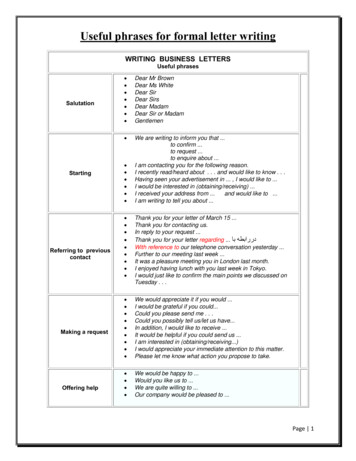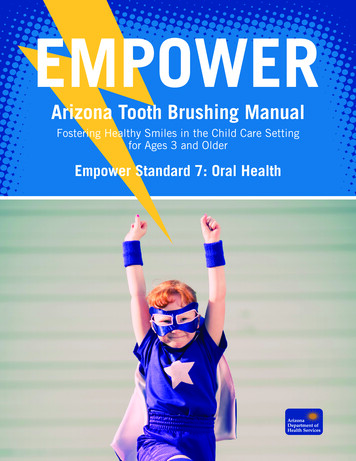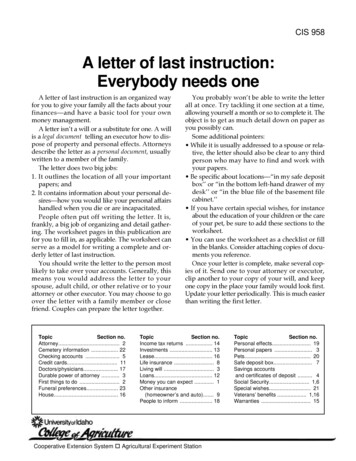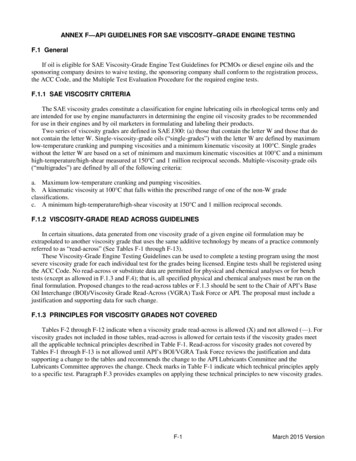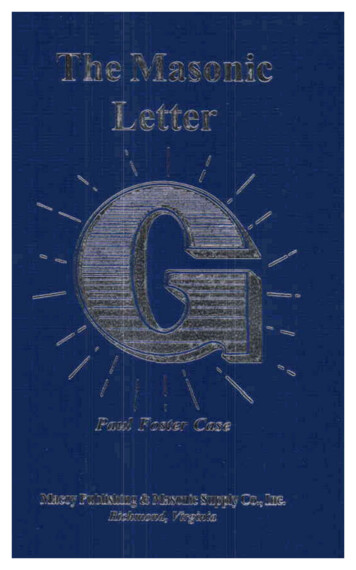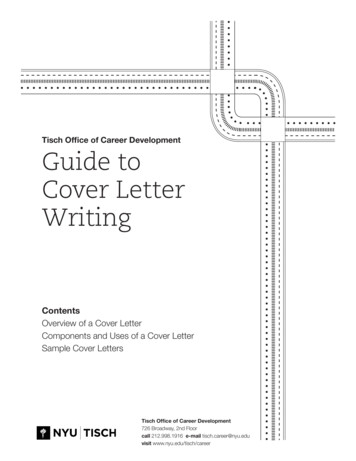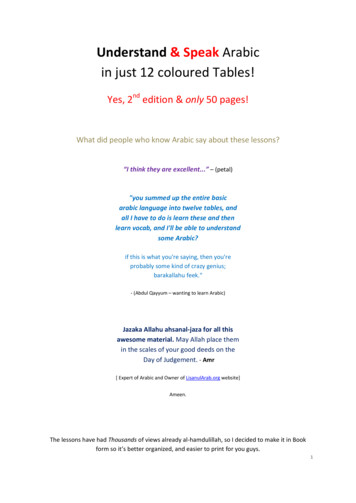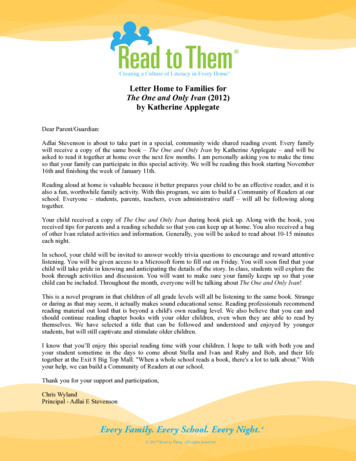
Transcription
Letter Home to Families forThe One and Only Ivan (2012)by Katherine ApplegateDear Parent/Guardian:Adlai Stevenson is about to take part in a special, community wide shared reading event. Every familywill receive a copy of the same book – The One and Only Ivan by Katherine Applegate – and will beasked to read it together at home over the next few months. I am personally asking you to make the timeso that your family can participate in this special activity. We will be reading this book starting November16th and finishing the week of January 11th.Reading aloud at home is valuable because it better prepares your child to be an effective reader, and it isalso a fun, worthwhile family activity. With this program, we aim to build a Community of Readers at ourschool. Everyone – students, parents, teachers, even administrative staff – will all be following alongtogether.Your child received a copy of The One and Only Ivan during book pick up. Along with the book, youreceived tips for parents and a reading schedule so that you can keep up at home. You also received a bagof other Ivan related activities and information. Generally, you will be asked to read about 10-15 minuteseach night.In school, your child will be invited to answer weekly trivia questions to encourage and reward attentivelistening. You will be given access to a Microsoft form to fill out on Friday. You will soon find that yourchild will take pride in knowing and anticipating the details of the story. In class, students will explore thebook through activities and discussion. You will want to make sure your family keeps up so that yourchild can be included. Throughout the month, everyone will be talking about The One and Only Ivan!This is a novel program in that children of all grade levels will all be listening to the same book. Strangeor daring as that may seem, it actually makes sound educational sense. Reading professionals recommendreading material out loud that is beyond a child's own reading level. We also believe that you can andshould continue reading chapter books with your older children, even when they are able to read bythemselves. We have selected a title that can be followed and understood and enjoyed by youngerstudents, but will still captivate and stimulate older children.I know that you’ll enjoy this special reading time with your children. I hope to talk with both you andyour student sometime in the days to come about Stella and Ivan and Ruby and Bob, and their lifetogether at the Exit 8 Big Top Mall. "When a whole school reads a book, there's a lot to talk about." Withyour help, we can build a Community of Readers at our school.Thank you for your support and participation,Chris WylandPrincipal - Adlai E Stevenson
Read Aloud Tips for Grown Ups Make reading time a priority – Sit down as a family and decide on a daily reading time,and then consider it an appointment that needs to be kept. Some families might find thatright before bed is the best time, but early risers might enjoy reading at breakfast. Foryounger listeners, bath time can be great! Build it into your daily routine and soon youwill find that everyone is ready and waiting to hear what comes next in the story. Show emotion that matches the story – All of the books for One School, One Bookcapture a range of emotions over the course of the story. When reading aloud, mirroringthe emotions felt by the characters will make the story more meaningful to your listener. Vary your rhythm – Have fun with the language in your book. During suspensefulsections, slow down and let the suspense build. During a particularly meaningfulmoment, pause and let the impact settle. During emotion-packed scenes, drop your voiceto a whisper. When you are reading aloud, you are performing the story. Authors don’twant their stories performed in monotone! Don’t be afraid to be silly – Accents, funny voices, and sound effects are all great tools touse to make reading aloud more engaging. Character-specific voices or mannerisms alsohelp listeners follow the dialogue. It might be a challenge, but it’s worth the effort tomake your story come alive. Stay engaged with your listener throughout your reading time – Stop from time to time toexplain an unfamiliar vocabulary word, discuss an important point, or ask your child tomake a prediction. You don’t want to derail the story too much, but you do want to makereading together interactive. Expect some fidgeting – Listening during reading time does not have to be a stationaryactivity. Some listeners will sit still as stones with eyes and ears fixed on you, and that’sgreat. But other listeners stay more engaged with something in their hands like a smalltoy, some crayons, or a stuffed animal. Some children might listen better if allowed towalk around the room, or even bounce on the bed a bit. Work together to find the waythat works best for your child.Great reading aloud makes you part of the story.
Reading Schedule forThe One and Only Ivanby Katherine ApplegateWeek 1:Nov.16pp. 1 – 31hello; names; patience; how I look; the exit 8 big topmall and video arcade; the littlest big top on earth;gone;artists; shapes in clouds; imagination; the loneliestgorilla in the world; tv; the nature show; Stella; Stella’strunkWeek 2:Nov. 23pp. 32 – 50a plan; bob; wild; picasso; three visitors; my visitorsreturn; sorry; julia; drawing bob; bob and julia; mackWeek 3:Nov.30pp. 51 – 84not sleepy; the beetle; change; guessing; jambo; lucky;arrival; stella helps; old news; tricks; introduction; stellaand ruby; home of the one and only ivanWeek 4:Dec. 7pp. 85 – 120art lesson; treat; elephant jokes; children; the parkinglot; Ruby’s story; a hit; worry; the promise; knowing; fivemen; comfort; crying; the one and only IvanWeek 5:Dec. 14pp. 121 – 160once upon a time; the grunt; mud; protector; a perfectlife; the end; vine; the temporary human; hunger; stilllife; punishment; babies; beds; my place; nine-thousandeight hundred and seventy-six days; a visit; a newbeginning; poor Mack; colors
Week 6:Dec. 21pp. 161 – 181a bad dream; the story; how; remembering; what theydid; something else to buy; another Ivan; days; nights;project; not right; going nowhereWeek 7:Dec. 28pp. 182 – 203bad guys; ad; imagining; not-tag; one more thing; theseven-o’clock show; twelve; H; nervous; showing juliaWeek 8:Jan. 4pp. 204 – 248more paintings; chest-beating; angry; puzzle pieces;finally; the next morning; mad human; phone call; a staragain; the ape artist; interview; the early news; signs onsticks; protesters; check marks; free Ruby; new box;training; poking and prodding; no painting; more boxes;good-byeWeek 9:Jan. 11pp. 249 – 300click; an idea; respect; photo; leaving; good boy;moving; awakening; missing; food; not famous;something in the air; a new tv; the family; excited; what Isee; still there; watching; she; door; wondering; ready;outside at last; oops; what it was like; pretending; nest;more tv; it; romance; more about romance; grooming;talk; the top of the hill; the wall; safe; silverback
Strategies for Using VocabularyYour schoolwide reading event should be fun and engaging, and while it is a school activity, it should not be“schoolwork” or “homework.” Because of this, we’re offering some ways to shift the vocabulary portion of theprogram from rote memorization to games and activities that can be used to explore vocabulary in a fun way thatteachers, parents, and students can all enjoy. Here are some of our favorites:1.Vocabulary in Rhyme – Challenge your students to create rhyming couplets that use each word in a waythat shows the definition. You can do this in small groups by dividing your class into teams and giving eachteam a set of words to work on. Have each group come up with a fun way to perform their rhymes.(Example: If the word is content (happy), a couplet could be something like, “Long bike rides give mesmiles; I’m content for miles and miles.”)2.Vocabulary Candy Land – Make a board game out of the vocabulary list. Put the words on cards and givedifferent point values to them based on their level of difficulty. Players that correctly provide the definitionmove forward the number of spaces corresponding to the point value. Be sure to add some wild cards in thedeck that send players far forward or backward. And perhaps even play it outside by drawing the boardwith sidewalk chalk!3.Vocabulary Jeopardy – Give the definition and have students guess the word. Give different point levelsbased on the difficulty of the word. You can be creative with the definition by not defining the worddirectly, but coming up with clues that provide enough context to lead them to the correct word. Or, givedictionary definitions for a lower point value clues and let the clues get a bit more vague and abstract forclues with higher point values.4.Vocabulary Charades – Students take turns being given the definition of a word to act out, and theremaining students have the opportunity to guess the word being displayed. This can be turned into acompetition by assigning one point to the actor and the first correct guesser. The student with the mostpoints wins.5.Vocabulary Pictionary – This is just like the charades activity above except that instead of acting out theword, the student has to draw it out for others to guess. Scoring is the same if you choose to make it acompetition.6.Vocabulary Bingo – Pass out premade Bingo cards to your students that display some of the vocabularywords in random order. Not every word should be on each card, and be sure that none of the cards matchesanother. Play the game by calling out the definition of a word and giving students time to place a markerover the word that’s defined if it appears on their card. Repeat until someone completes a full row orcolumn and shouts, “BINGO!”7.Vocabulary Improv – Select a vocabulary word to be the starting point for your activity. Use it in adescriptive sentence to start a story. Have students choose a new word from the list to add to the story, onesentence at a time. Let them try to do this without following the plot of your book.
8.Synonyms – Split students into teams, each with a different list of vocabulary words. Give them a set timeto search for synonyms of the words on their list (5-10 minutes), and then have them take turns competingagainst each other by listing off the synonyms of one word from their list one at a time until someone fromthe other team guesses the vocabulary word that has the same meaning. This activity can be scored if youlike simply by tallying the number of synonyms given before the other team guesses. The more synonymsneeded, the higher the score, and the lowest score wins.9.Heads Up – Give each student a post-it note with a vocabulary word on it, and have them affix them totheir foreheads. Tell the students to mingle and interact with one another by sharing hints about what’s onanother student’s forehead. Challenge your students to avoid sharing definitions or synonyms of the word.Instead they should provide contextual clues that can lead them to being able to guess the word. Give thema set time (3-5 minutes), and ask them to interact with at least 5 other students. When the time is up, askeach student if they can guess what their word is.10.Gibberish – This is a fun creative writing activity. Have your students write a short story about one of yourvocabulary words but replacing that word with a bit of gibberish. Ask them to include the word in the storyat least 5 times. The challenge is to not directly define the word but provide enough context to help readersguess the replaced word. (Example: If the real word is veterinarian, the gibberish word could be zumbel.Oscar was limping yesterday, so I took him to visit the zumbel. The zumbel looked at one of his backlegs.)11.Efficient Definitions – This activity is great editing practice! Have students—separately or in teams—whittle down dictionary definitions of the words together to see if they can concisely define the vocabularyword in as few words as possible.12.Word of the Day – Select a word to highlight on a particular day and challenge students to see how manytimes they can work it into their conversations. This can be done every day during your reading event, but itcan also extend beyond your time with the book. Continue using additional words from the book orelsewhere throughout the school year. You can even put your increased vocabulary on display by creating apaper chain by writing each mastered word on a small strip of paper and taping it into a circular link. Add anew link to your chain each day and watch it grow!Reading aloud is a great way increase and grow your students’ vocabulary, and we hope that these activities willbuild upon that practice to help these words fully stick with them. Even after your time with the book is over,continue to use the words learned just to reinforce the learning. And continue to revisit them in fun ways byreplaying some of these games. You can even play many of them again with new words throughout the year to makelearning continue to be fun!
#AdlaiIvan Check your email and social media accounts each Monday for your weekly assignmentand then again on Friday for your reading log. Ivan is going to pick a Caught BeingGood winner each week based on amazing we responses we get within the reading logs. We will be reading the story The One and Only Ivan in our school community. In thestory, Ivan was kept in an enclosure at the mall! Ivan could not go out into the realworld. One activity we want the children to work on is to make their own “Ivan” to showoff to friends and/or family on the Adlai Stevenson Facebook page #AdlaiIvan so thatwe can see all the amazing things you are doing at home to support our reading. Wewould like to hear from each of you! Please have your child(ten) color and cut out theirIvan to use when working on activities at home. Just snap a picture and post it to our FBpage #AdlaiIvan. Please visit the page often and show your child what other families aredoing with Ivan as well. If you’re reading, working on an activity or just playingoutside. Grab Ivan, snap a pic and post! Thank you for your support through this funlearning activity! We are so excited to get started!!! Use the blank sheet of card stock to make a bookmark! Post your completed bookmarkon our FB page #AdlaiIvan. Use the book to journal, draw pictures while you are reading or to write your own story.Post what you’re doing on our Facebook page #AdlaiIvan
The One and Only IvanName:Sheet #1b, Chapter 1-5Date:Knowing our Narrator (Continued)6) Who are the narrator’s best friends?7) How does the narrator feel about being related to humans, chimpanzees, orangutans, and bonoboos?8.What does the narrator think about his picture on the billboard?9.Why is Ivan never angry?10. On pg. 1, the narrator states, “It’s not as easy as it looks.” What do you think is not easy about the narrator’s life?
The One and Only IvanName:Sheet #2, Chapter 1-5Date:See the SettingGood readers visualize, or create pictures in their mind. This is an especially important strategy when the setting of astory is being described. The setting is where and when the story takes place. Ivan describes the setting of thestory (otherwise known as his domain) in great detail.Directions: Draw Ivan’s domain (or setting) in the box below.
The One and Only IvanSheet #3, Chapter 6-10Name:Date:Human HabitsThe reader learns about humans from Ivan’s point of view.Directions: In the space provided, write what you have learned about humans from Ivan.For example: what they do, how they behave (at the mall), what they think, etc.HUMANS
The One and Only IvanSheet #4, Chapter 6-10Name:Date:Analyzing ArtistsIvan says that both he and Julia are artists.Directions: Using the Venn Diagram below, compare and contrast Ivan and Julia as artists.JuliaIvan1)1)1)2) 2)2)3) 3)3)4) 4)5)5)1)How much does Ivan’s artwork sell for?2)Today, Ivan uses paper to draw on. What did he use when he was a baby?
The One and Only IvanSheet #5, Chapter 11-13Name:Date:Terrific TelevisionDirections: Ivan spends some time watching television in his domain. In each television set below, draw apicture to represent the type of show that Ivan watches. Write the type of show on the blank line below eachtelevision.Think about it!1)Why does Bob say that Westerns are nothing like real life?
The One and Only IvanName:Sheet #1a, Chapter 1-5Date:Knowing our NarratorAn author can tell a story using first person point of view or third person point of view.Let’s look at both points of view.Third-Person Point of ViewFirst-Person Point of ViewA character in the story is the narrator. This character istelling the story. The narrator uses the pronouns I, meand we.In the first-person point of view, readers learn aboutevents as the narrator learns about them.The story is being told by an outside observer (someonewho is not in the story). This narrator uses the pronounshe, she and they.In third-person point of view, the narrator can tell aboutthe thoughts, actions, and feeling of all the characters.1) What point of view is The One and Only Ivan told in?2) Who is the narrator?3) What other names does the narrator have?4) Where does the narrator live?5)Has the narrator always lived there? How do you know?
The One and Only Ivan (2012) by Katherine Applegate Dear Parent/Guardian: Adlai Stevenson is about to take part in a special, community wide shared reading event. Every family will receive a copy of the same book – The One and Only Ivan by Katherine Applegate – and will be asked to re





